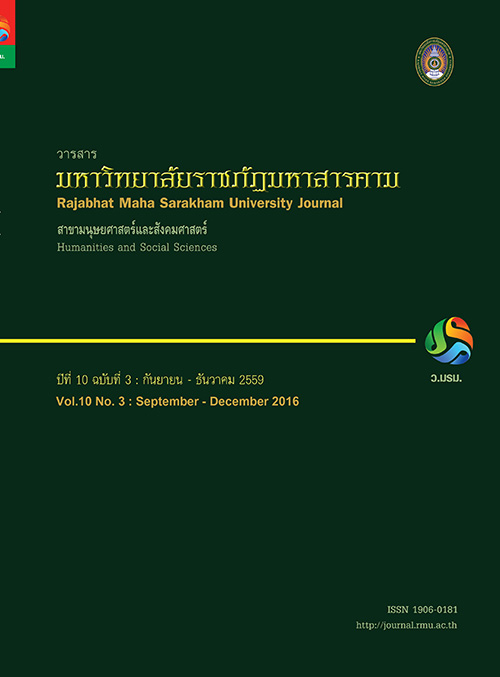การพัฒนาตัวบ่งชี้และคู่มือโรงเรียนปลอดภัยของสถานศึกษา สังกัดสำนักงานคณะกรรมการการศึกษาขั้นพื้นฐาน;The Development of Indicators of Safety School Guide of the BasicEducation Commission Office
Main Article Content
บทคัดย่อ
การวิจัยนี้มีวัตถุประสงค์ เพื่อพัฒนาตัวบ่งชี้และคู่มือโรงเรียนปลอดภัย และทดสอบความสอดคล้องของโมเดลการวัดตัวบ่งชี้
โรงเรียนปลอดภัยของสถานศึกษา สังกัดสำนักงานคณะกรรมการการศึกษาขั้นพื้นฐานที่พัฒนาขึ้นกับข้อมูลเชิงประจักษ์ โดยการวิเคราะห์
องค์ประกอบเชิงยืนยัน กลุ่มตัวอย่าง ได้แก่ ครูในสถานศึกษาเครือข่ายโรงเรียนปลอดภัย 280 คน เครื่องมือที่ใช้ในการเก็บรวบรวม
ข้อมูลการวิจัยเป็นแบบสอบถามมาตราส่วนประมาณค่า 5 ระดับ มีค่าความเชื่อมั่นทั้งฉบับเท่ากับ 0.941 มีค่าความตรงเชิงเนื้อหา
อยู่ระหว่าง 0.60 - 1.00 วิเคราะห์ข้อมูลโดยใช้โปรแกรมคอมพิวเตอร์สำเร็จรูป ผลการวิจัยพบว่า
1. ผลการพัฒนาตัวบ่งชี้โรงเรียนปลอดภัยของสถานศึกษา สังกัดสำนักงานคณะกรรมการการศึกษาขั้นพื้นฐานพบว่ามี 5 องค์
ประกอบหลัก และ 46 ตัวบ่งชี้ดังนี้ 1) องค์ประกอบหลักด้านการป้องกันภัยด้านสิ่งแวดล้อม มี 11 ตัวบ่งชี้ 2) องค์ประกอบหลักด้าน
การคุ้มครองและช่วยเหลือมี 16 ตัวบ่งชี้ 3) องค์ประกอบหลักด้านการป้องกันและเฝ้าระวัง มี 8 ตัวบ่งชี้ 4) องค์ประกอบหลักด้าน
การส่งเสริมและพัฒนาผู้เรียน มี 6 ตัวบ่งชี้ และ 5) องค์ประกอบหลักด้านหลักสูตรความปลอดภัย มี 5 ตัวบ่งชี้โดยพบว่า องค์ประกอบ
หลักที่มีค่านํ้าหนักองค์ประกอบมาตรฐานสูงสุด คือ องค์ประกอบหลักด้านการป้องกันและเฝ้าระวัง (B = 1.02)
2. ผลการทดสอบความสอดคล้องของโมเดลการวัดตัวบ่งชี้โรงเรียนปลอดภัยของสถานศึกษา สังกัดสำนักงานคณะกรรมการ
การศึกษาขั้นพื้นฐานพบว่าโมเดลมีความสอดคล้องกับข้อมูลเชิงประจักษ์ (Chi-Square = 73.36, df = .58, p = 0.08418, GFI =
0.96, AGFI = 0.93, RMSEA = 0.031)
3. ผลการสร้างคู่มือโรงเรียนปลอดภัย พบว่า มีค่าเฉลี่ยระดับความเหมาะสมของการประเมินคุณภาพคู่มือจากผู้เชี่ยวชาญ
7 คน อยู่ในระดับมาก และมีค่าเฉลี่ยความคิดเห็นทั่วไปเกี่ยวกับคู่มืออยู่ในระดับมากที่สุด สามารถนำไปใช้ในการดำเนินงานโรงเรียน
ปลอดภัยให้เกิดประโยชน์ตามวัตถุประสงค์ได้
This research aimed to develop indicators of Safety School Guide of the Basic Education Commission
Office, and to examine the goodness of fit of the structural relationship model of safety school indicators
developed by the researcher with empirical data. The sample for this study consisted of 280 teachers of safety
school network. The instrument used for collecting data of this study was a five-level rating scale questionnaire
with 0.941 reliability and content validity of 0.60 -1.00. The collected data were analyzed by using a computer
software programResults of the study are as follows:
1. Results of developing of the conceptual framework and indicators of safety school. This model
consists of 5 major factors and 46 indicators as follows: 1) The major factor regarding Environmental Protection
consists of 11 indicators; 2) The main factor regarding Protection and Assistance consists of 16 indicators ;
3) The major factor regarding Prevention and Surveillance consists of 8 indicators; 4) The major factor regarding
Promotion and Development consists of 6 indicators and 5) The major factor regarding Safety course consists
of 5 indicators
2. The goodness of fit of the structural relationship model of safety school of the Basic Education
Commission Office indicators with the empirical data reveal that the model is in congruence with the empirical
data. (Chi-Square = 73.36, df = .58, p = 0.08418, GFI = 0.96, AGFI = 0.93, RMSEA = 0.031)
3. The creation of the safety school guide indicates that the mean of7 experts’ assessment on its
suitability is at high level (=4.43) and the mean of general opinions on the guide is at the highest level
(=4.54) which lead to the conduction of the safety school project for the best use as it was purposed.
Article Details
1. บทความที่ลงตีพิมพ์ทุกเรื่องได้รับการตรวจทางวิชาการโดยผู้ประเมินอิสระ ผู้ทรงคุณวุฒิ (Peer Review) สาขาที่เกี่ยวข้อง อย่างน้อย 3 ท่าน ในรูปแบบ Double blind review
2. ข้อคิดเห็นใด ๆ ของบทความที่ลงตีพิมพ์ในวารสารมหาวิทยาลัยราชภัฏมหาสารคาม นี้เป็นของผู้เขียน คณะผู้จัดทำวารสารไม่จำเป็นต้องเห็นด้วย
3. กองบรรณาธิการวารสารมหาวิทยาลัยราชภัฏมหาสารคาม ไม่สงวนสิทธิ์การคัดลอกแต่ให้อ้างอิงแสดงที่มา


